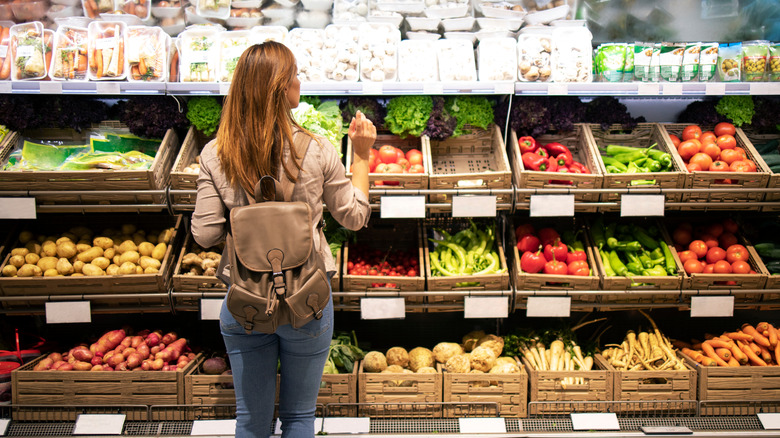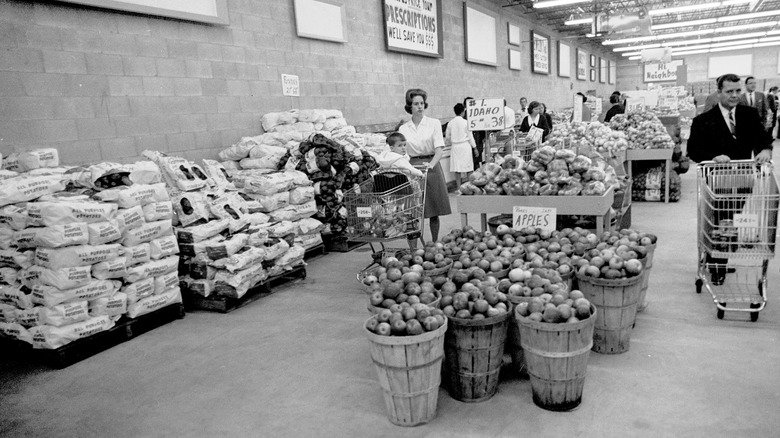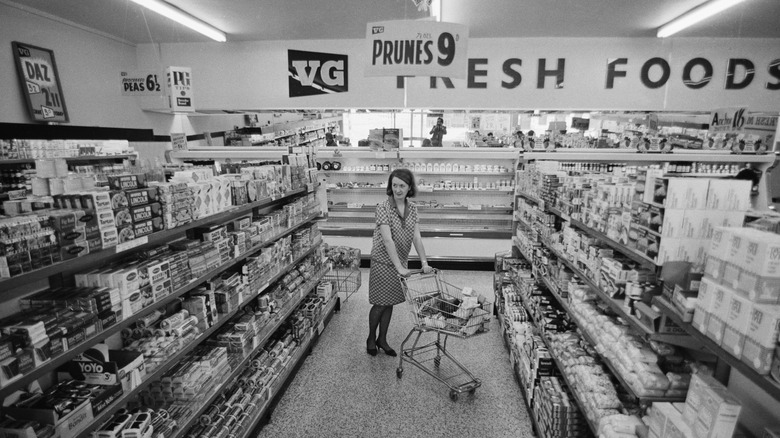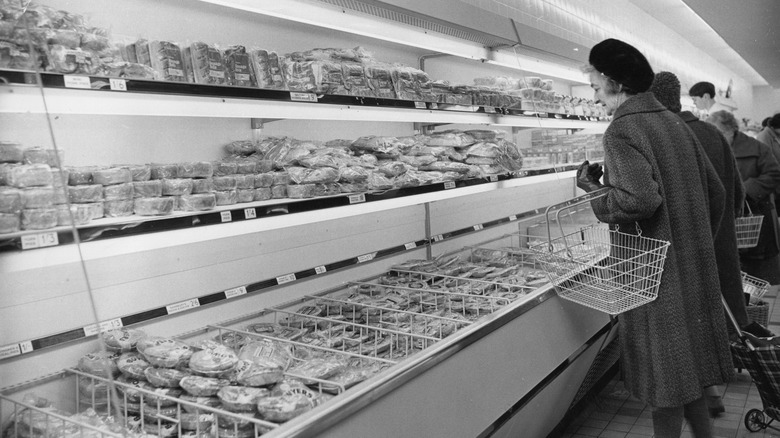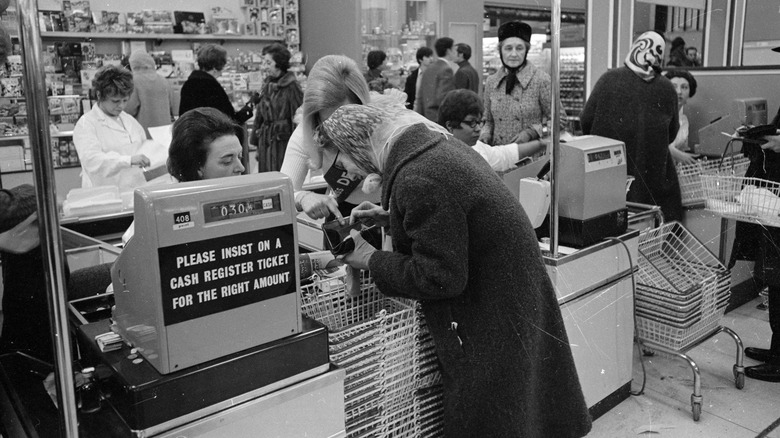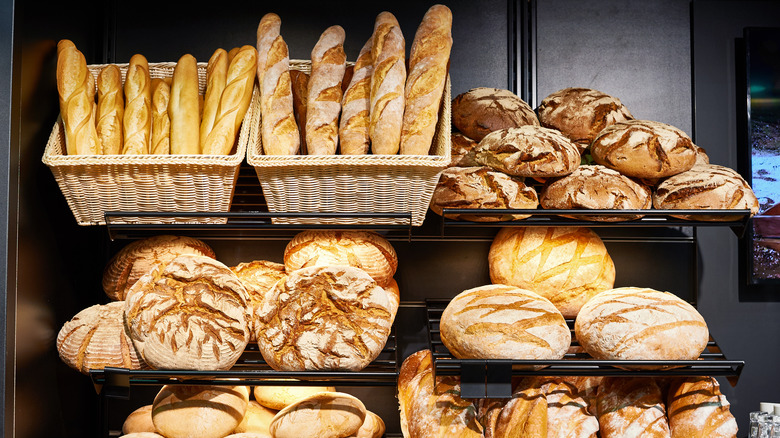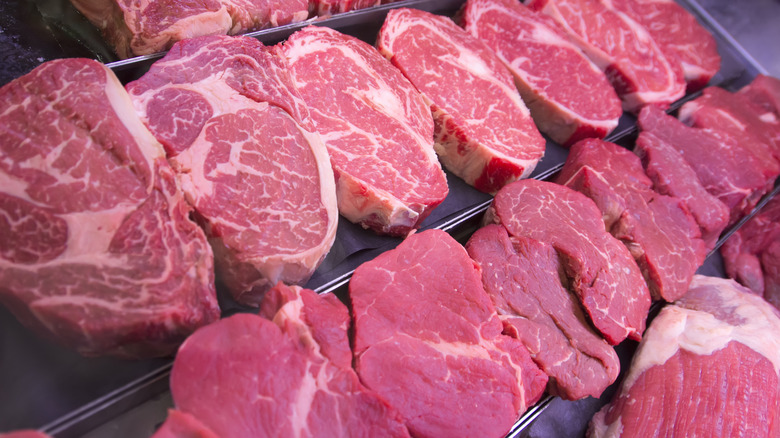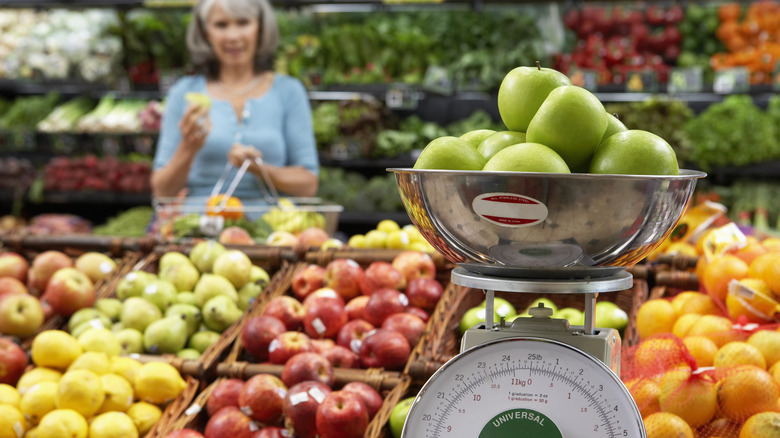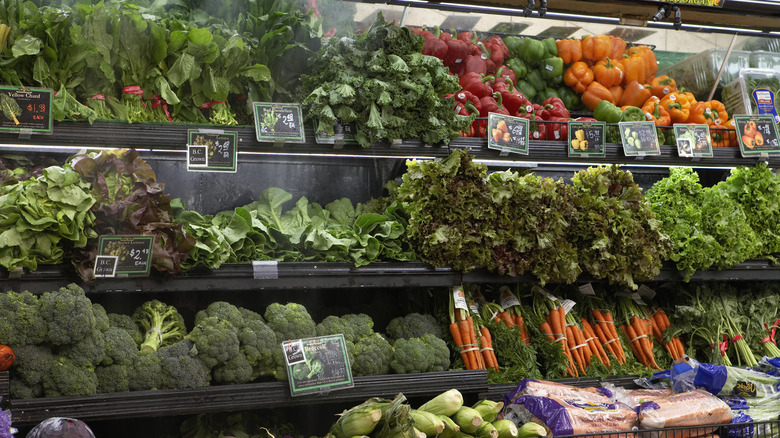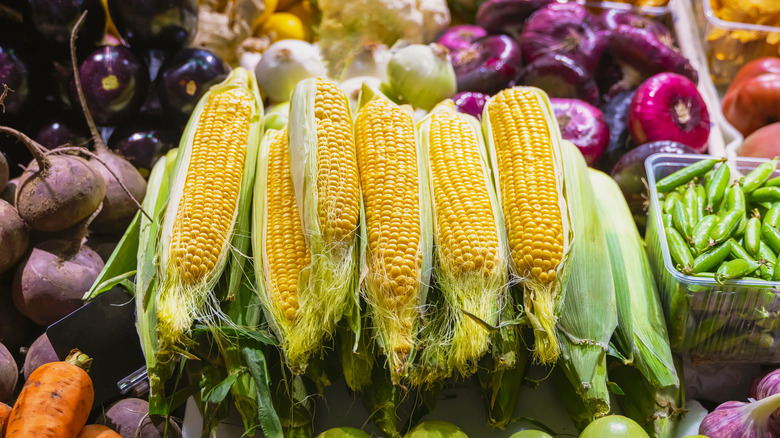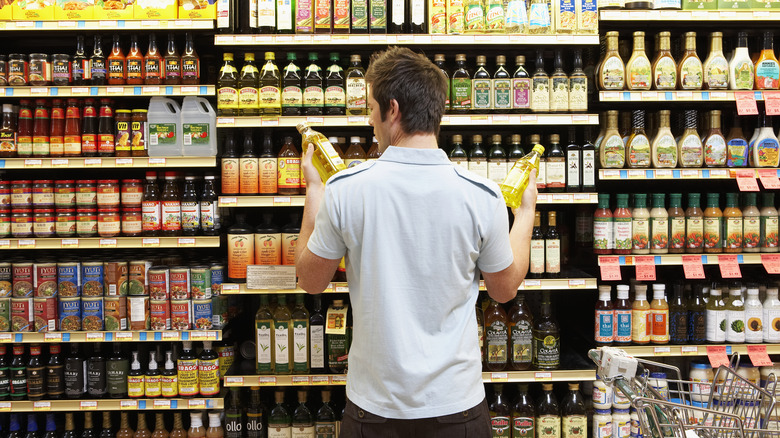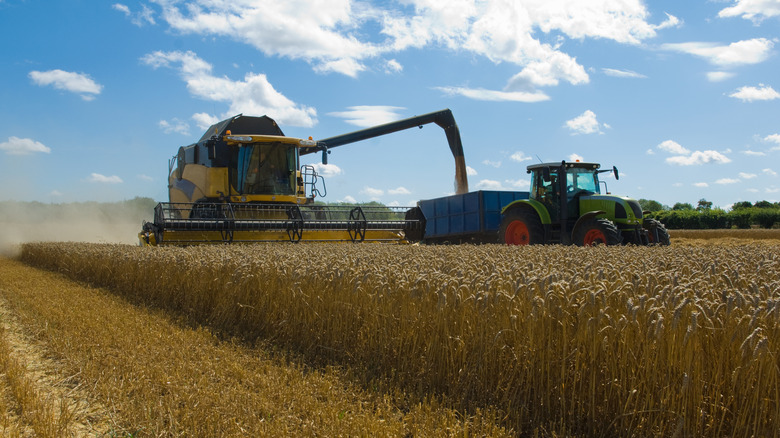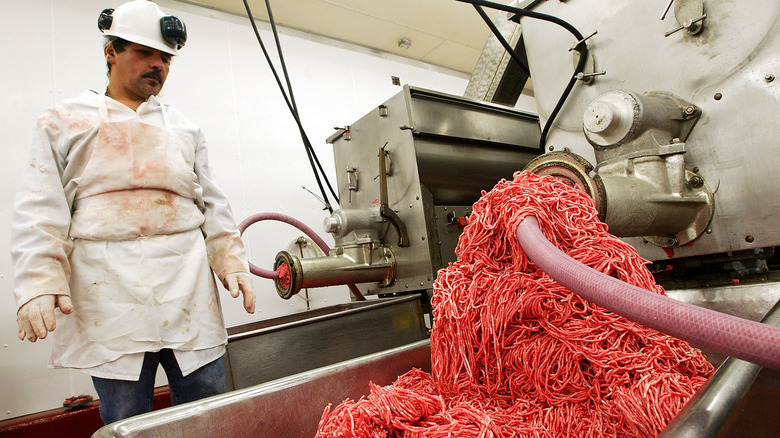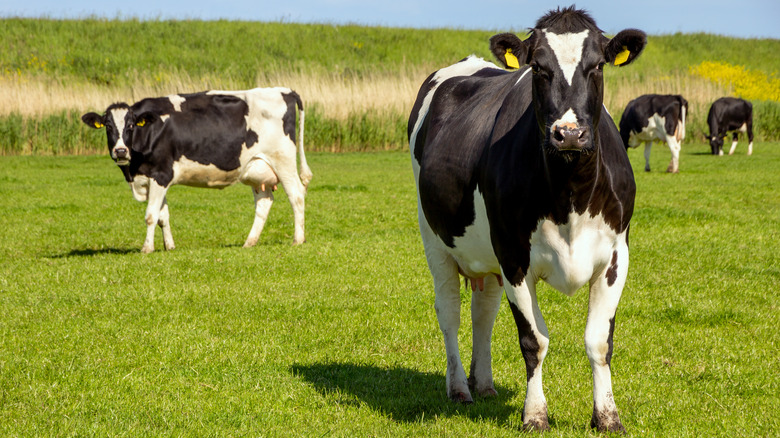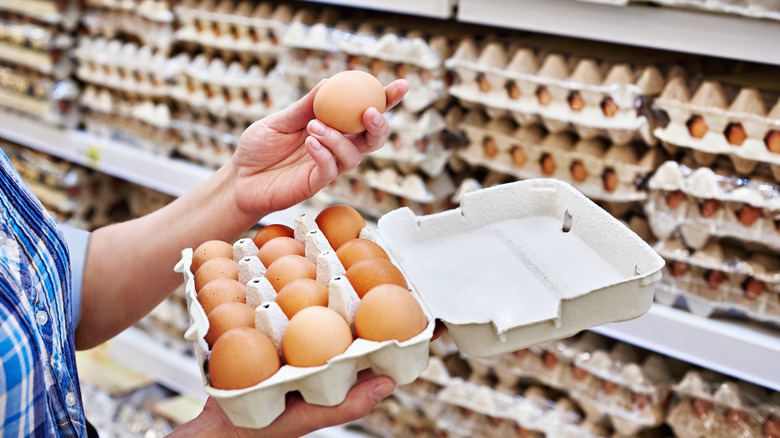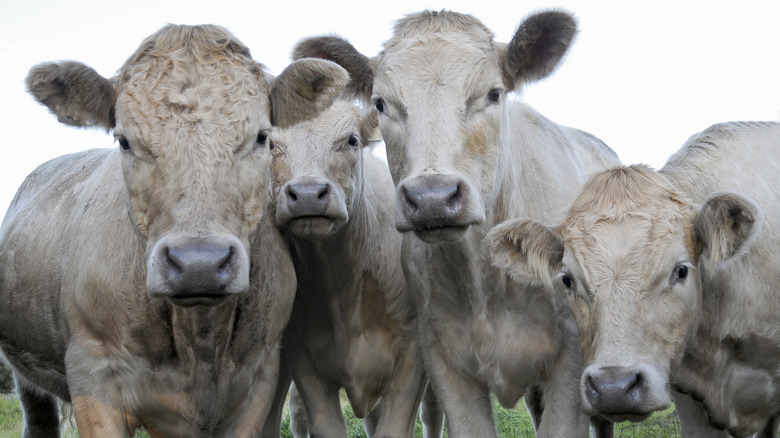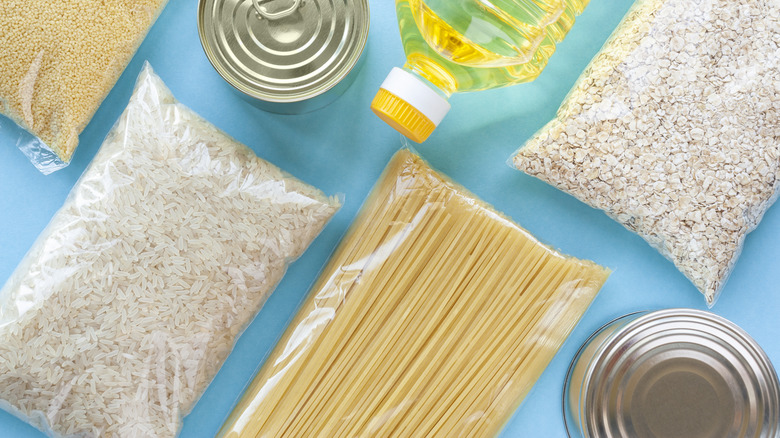How Much Popular Grocery Store Items Really Cost The Year You Were Born
Grocery shopping: everyone does it, but no one enjoys seeing the total for their bill at the end of a shopping trip. These days, it feels as though grocery prices are always on the rise, even on popular staples like bread, meat, and produce. As a result, many shoppers long to see grocery prices return to the lower levels they were in the past. A quick look at grocery bills from the year you were born might make it seem like consumers of the past were guaranteed a bargain.
However, prices are just one part of the story, and they are not always what they seem to be. Over the last six decades, grocery bills have increased far more often than they've decreased thanks to various historical events. From weather and wars to surpluses and shortages, food prices the year you were born may not have been as idyllic as you'd like to believe. In fact, some years make today's grocery prices look like a bargain.
Supply chain issues drove prices up in 1964-1965
Farming practices and setbacks significantly impacted grocery store prices between 1964 and 1965. Prices rose thanks to the lower availability of some staples, especially produce. The Palm Sunday Tornado outbreak of 1965 devastated some farming areas in the Midwest, leading to decreased crop yields. In particular, potato lovers saw a staggering price hike in their favorite starch, with a ten-pound bag rising to an average of 93 cents — over 20 cents more expensive than five years prior.
Furthermore, a winter freeze destroyed a significant percentage of Florida's orange crop in 1962 and consumers still felt the effect of that crop loss in 1965. Oranges averaged 77 cents per dozen, whereas other popular fruits, such as apples and bananas, were only about 14 cents per pound. Thanks to reduced livestock production, meat prices also rose. Beef, pork, and veal saw the largest increases, especially when pork shortages led to a greater-than-normal demand for beef.
The Vietnam War contributed to price hikes from 1966-1968
Lyndon B. Johnson's so-called "War On Poverty" aimed to provide relief for those struggling financially, but increased U.S. involvement in the Vietnam War still had a negative impact on grocery bills. As is typical for times of war, inflation rose rapidly and food prices rose with it. Families found themselves paying more for everyday staples, including meat and dairy. Additionally, the military draft drained a percentage of the rural labor force, leading to widespread farming changes. Meat prices were high in 1966, with ground beef costing 49 cents per pound and pork chops coming in at 89 cents per pound.
Rising costs in this period led to a food crisis for many, but particularly for lower-income people and families. In 1968, CBS aired a stunning documentary called "Hunger in America," highlighting widespread poverty and food insecurity across the U.S. The documentary explains that ten million Americans struggled with hunger in 1968 and features harrowing interviews with families who couldn't afford to feed their children.
A recession failed to slow rising food prices in 1969-1970
To slow the endless upward climb of food prices, the U.S. government generated an economic recession from 1969-1970. This relatively minor recession presented an opportunity to tamp down some of the decade's rampant inflation. Policies enacted during this short window temporarily brought some homeostasis back to the U.S. economy. But unfortunately, high inflation and the domestic consequences of the Vietnam War continued to plague grocery shoppers.
In 1969, coffee cost as much as $1.19 for a three-pound canister, and a loaf of bread was 29 cents. By 1970, even sale prices on ground beef had risen to 59 cents per pound. However, a growing food trend helped some shoppers make their grocery bills more affordable. After the mainstream expansion of frozen food lines in the mid-1960s, consumers began trading freshness for convenience more than ever before. By offering frozen options, companies such as Green Giant and Birds Eye made it easier for shoppers to afford products such as vegetables and pre-made meals.
President Nixon imposed a price freeze in 1971
After the short-term recession of 1969-1970 failed to provide lasting relief for American consumers, the Nixon administration took more drastic action in 1971. First, Nixon imposed a temporary wage-price freeze, which created a brief measure of stability. The goal of the policy was to curtail the increasing gap between wages and cost of living. However, the price freeze (and subsequent longer-term controls) only lasted until Nixon secured reelection in 1972.
Consumers still faced sticker shock at their local stores despite this momentary reprieve from soaring costs. Even the most essential items had already fallen victim to significant price hikes across the 1960s, and those prices rose even higher during this year. For example, the cost of butter was over 86 cents on average, up 11 cents from its 1965 price. A carton of eggs, another popular product in the dairy section, cost around 61 cents. Meat products also broke the bank for many shoppers, including pork chops, which rang up at $1.16 per pound.
Commodity inflation caused new grocery price woes between 1972-1974
Various economic factors contribute to inflation, but the period from 1972-1973 was a special case. According to The New York Times, a phenomenon known as commodity inflation spurred widespread food price increases. The article explains that commodity inflation primarily impacts raw materials, making it even more challenging to control than traditional inflation. After food price inflation reached a staggering 20%, many consumers began protesting at local supermarkets.
Although Nixon reinstated some price control measures, it did little to slow the ever-climbing cost of feeding a family. For example, a loaf of bread went from around 22 cents in 1973 to 36 cents in 1974. However, bread wasn't the only popular item to experience such a large price hike. In mid-July of 1973, The New York Times reported that a dozen eggs cost 83 cents, and an egg shortage would drive prices even higher. Furthermore, staples such as corn doubled in price between 1972 and 1974.
The Great Inflation was at its peak from 1975-1977
As if the average American grocery shoppers weren't already having a hard enough time in 1974, The Great Inflation of 1975-1977 made it even more difficult to stretch a dollar. In mid-1975, The New York Times reported that the cost to feed an average American family was at an all-time high, partially because of skyrocketing beef costs. Ground beef cost 68 cents per pound at the beginning of 1975, but continued to climb. Meanwhile, a dozen eggs cost 72 cents and apples were up to 19 cents per pound.
Inflation temporarily slowed in 1976 but rose again starting in 1977. An article in The Washington Post pointed to increased farm prices as a significant factor in retail food costs. The report indicates that staples such as coffee, cereal, and pork all experienced price increases. A WTVJ news segment from 1977 (via Facebook) covered the rising, volatile prices that people in South Florida faced, noting that coffee prices hit a record high while the price of sugar and chicken had surprisingly gone down.
Weather events led to volatility from 1978-1979
Unfortunately, weather can sometimes significantly affect the price of popular grocery items. For instance, in 1978, The New York Times reported that Los Angeles experienced 26 inches of rainfall in a single day, the highest-ever amount by that point in the twentieth century. Around the state, similar record rainfall totals led to widespread crop loss. In Northern California, a Humboldt County agricultural report demonstrated reduced crop yields on staples such as tomatoes, potatoes, and corn.
In other parts of the country, winter blizzards delayed the transportation of goods to local grocery stores (via The New York Times), which caused price hikes in those areas. Meat and poultry prices weren't immune to increases, either. According to The Washington Post, a beef shortage drove prices up 14% in the first half of 1978. However, there was one small bright spot in this period of high prices: a gallon of milk cost $1.62 in 1979, which was lower than the previous year.
Changes in dietary preferences influenced costs in 1980
Healthy living became a bigger focus in the 1980s, including changes to the typical American diet. Many consumers began moving away from a traditional meat-heavy diet in favor of more balanced options, and public health publications likely influenced this shift. In 1980, the American Dietetic Association (now the Academy of Nutrition and Dietetics) published its first-ever paper about the potential benefits of a vegetarian diet. The 1980 Dietary Guidelines For Americans also advised eating a varied diet for optimal health, including more fruit and vegetables.
Across the decade, red meat consumption dropped by 10% due to this change in dietary choices, which had a positive impact on prices. In a KMOV news segment from June of 1980, a reporter found pork steaks discounted to just 68 cents a pound. Ground beef was also a bargain at $1.38 a pound, one cent less expensive than at the beginning of 1979. Over all, shoppers interviewed for the segment indicated that prices seemed more stable and found some products cheaper than in recent years.
Shoppers enjoyed price stability between 1981-1983
For those in charge of buying their household's groceries, 1981-1983 was a great time. Food costs finally stabilized after the extreme inflation of the 1970s, and some everyday staples began to go down in price. Meat and pork prices varied widely across 1981, but the fluctuations were far more minor than in the previous decade. Ultimately, beef and poultry surpluses led to grocery stores slashing prices, with ground beef selling for an average of $1.50 per pound.
Food prices remained relatively predictable for the next few years, which meant more straightforward consumer budgeting. In 1983, UPI reported that decreased inflation and increased food availability contributed to lower price hikes than in the last ten years. For example, a dozen eggs only cost 67 cents in 1983, almost twenty cents less than in 1979. Meanwhile, a gallon of milk rose to $2.24 in 1982, but that price remained steady through 1983.
The Midwest recovered from a Corn Belt Drought in 1984
In the summer of 1983, The New York Times reported that a widespread drought would negatively impact the year's corn crop. The drought affected The Corn Belt, an area of the U.S. that serves as a primary source of this staple. Although 1984 corn and other produce prices initially went up due to the drought, UPI reported that the corn crop of 1984 was among the largest in history. This rebound led to lower retail prices for consumers for the year's second half and represented a quick recovery from a would-be disaster.
However, shoppers saw the price for another popular grocery item trend in the opposite direction this year. For instance, UPI said several factors, including an avian flu outbreak and problematic winter temperatures, reduced the nation's egg supply. The article explains that a dozen eggs rose to $1.15 in early 1984, compared to just under 63 cents one year prior. However, some parts of the country had even higher egg prices, up to $1.59 or more for a dozen large eggs.
Prices fluctuated widely from 1985-1987
The mid-1980s grocery market was a far cry from the unchecked inflation and shortages of the 1970s, and 1985 even started with an optimistic prediction. A report from The New York Times indicated that farm surpluses were likely to result in the lowest food price increases since the 1960s. However, although 1985 lived up to its promise with some of the best prices of the decade, the next two years saw costs rise again. A 1987 Food Cost Review explained that higher cattle values led to a rise in beef prices, which significantly impacted overall grocery bills for consumers.
However, produce played an even more prominent role in how much Americans paid for their groceries in this period. The review highlights a 12% cost increase in fresh produce, which impacted everything from apples to tomatoes. For instance, a pound of white potatoes rose from 21 cents in 1985 to 28 cents in 1987. Meanwhile, lettuce prices climbed from only 54 cents per pound in 1985 to 63 cents per pound two years later.
The North American Drought impacted crops from 1988-1990
Droughts can be the most catastrophic of all the weather events that impact the world's food supply. For instance, the 1988-1990 North American Drought posed a significant crop threat and led to higher grocery prices. According to the Monthly Labor Review from May of 1989, the drought impacted the U.S. supply of staples such as soybeans, wheat, and dairy products. Thanks to these shortages and the effects of inflation, 1988 saw the most substantial price increases since 1984.
Unfortunately, 1989 featured even more pronounced changes in the cost of popular products. For example, The Los Angeles Times ran an article covering the rapid escalation of milk prices in 1989, which saw an increase of 9% in that year alone. According to the report, the drought contributed to higher feed costs for cattle, which led some farmers to reduce their herds. Grocery prices continued to reflect the effects of the drought in 1990, with ground beef topping out at $1.59 per pound and a dozen eggs rising to $1.01.
Food prices stabilized during a recession in 1991-1994
Recessions often have a major influence on the price of consumer goods, as was the case from 1991-1994. With a recession comes reduced demand, which drove down food costs in the U.S. Consumers enjoyed lower grocery bills across the board, and some products became more affordable than in previous years.
A USDA review of food costs in 1991 cited a growing recession and farmer surpluses as the source of a drop in price inflation. According to the report, poultry, eggs, and dairy products all cost less in 1991 than in the previous year. Now, shoppers could buy a dozen eggs for 99 cents, and a half-gallon of milk was $1.37.
Across the next few years, prices continued to stabilize or decrease across multiple categories. For instance, in 1992, Deseret News reported that ground beef cost $1.27 per pound, compared to $1.37 per pound in 1981. Although prices rose slightly in 1994, this period was one of the most peaceful times for grocery shoppers in almost a decade.
Grain supply problems caused a domino effect between 1995-1996
Grains are at the heart of many grocery store products, including cereal, bread, and other bakery items. However, the influence of grain on the overall food supply goes far beyond these popular products. Beef, poultry, and pork prices are also greatly impacted by grain availability since it serves as a primary food source for livestock. Between 1995-1996, a drought in the Midwest disrupted the country's grain supplies and led to skyrocketing feed costs for farmers.
Unfortunately, the cascade of consequences for lower grain supplies didn't stop there. The Monthly Labor Review for April 1997 notes that many farmers had to slaughter more livestock than usual in 1996. This change impacted the availability of milk and other dairy products, translating to higher grocery costs for consumers. For example, a dozen eggs cost $1.19 in 1995 but rose to $1.31 by 1996 — one of the highest prices of the decade.
A historic beef recall threatened the market in 1997
In 1997, meat eaters faced one of the biggest scares in modern U.S. food history. That summer, CNN reported that a Hudson Foods meatpacking plant in Nebraska voluntarily recalled all of its beef products due to safety concerns. The article notes that Hudson Foods was a major supplier of grocery stores and restaurants, both of which experienced product shortages after the recall. This recall resulted from an E. coli outbreak linked to contaminated meat from the plant. According to The Washington Post, the recall impacted 25 million pounds of beef and led to indictments from the federal government.
Surprisingly, the shortages caused by this recall had minimal impact on beef prices because the demand for beef decreased. A USDA Food Cost Review explained that beef prices remained stable throughout the year, with minimal change since 1996. However, prices of pork and chicken rose in response to increased demand for these products. The review also notes that fruit and vegetable prices rose in 1997, but did so less aggressively than in previous years.
Inexpensive produce drove down grocery bills in 1998-2000
The period between 1998 and 2000 was a great time to be a vegetarian. Food prices reached all-time lows in this period because of price drops and decreased inflation, with vegetables representing one of the best deals at the grocery store. In 1999, Supermarket News reported a 3.4% price reduction for fresh vegetables from the previous year, and some fresh fruit prices experienced equally promising decreases. For instance, red delicious apples were 94 cents per pound in 1998, but cost only 90 cents per pound in 1999.
Even meat and dairy products — often plagued with price increases — were more reliably affordable during this time. For example, although the price of milk experienced a brief price spike, climbing to $2.84 in 1999, it dropped to $2.78 in 2000. However, a Monthly Labor Review noted that inflation was on the rise in 2000, so some of the excellent prices of the late 1990s became a thing of the past by the end of the year.
The September 11 Attacks enabled agricultural disruption in 2001
In 2001, the September 11 attacks disrupted the U.S. agricultural sector and increased awareness of the vulnerability of the food supply. In addition, a Congressional Research Service report indicates that the nation experienced some food product loss due to import delays from Canada and Mexico. This short-term setback disturbed the flow of goods at the borders but didn't necessarily impact food prices.
Surprisingly, the cost of most grocery staples decreased in 2001 despite this tragedy. For example, The Guardian reported that a worldwide coffee surplus resulted in price drops, with a pound of arabica coffee falling from $1.26 to just under 60 cents. In addition, surpluses of crops such as tomatoes, strawberries, lettuce, and grapes also led to reduced prices in the produce section (via a Monthly Labor Review from March 2002). In particular, the cost of grapes dropped by five cents between 2000 and 2001 and continued this gradual decline over the next two years.
Supply shortages made eggs more expensive from 2002-2003
Of all the grocery products that U.S. shoppers commonly buy, a dozen eggs has experienced some of history's most considerable price fluctuations. Although UPI reported that grocery store prices decreased on many staples in 2002, eggs followed the opposite trend by becoming significantly more expensive by 2003. As StarNews Online explained, the sharp increase in the price of eggs stemmed from various factors, including supply shortages and disease.
However, eggs were just one product that experienced a price increase. A Monthly Labor Review revealed that fresh vegetables such as lettuce, broccoli, and bell peppers became more expensive in 2003 due to unexpected weather conditions in the spring. Furthermore, UPI explained that potatoes went up to $2.63 for a five-pound bag in 2002, up 41 cents from the previous year.
Nevertheless, an increasingly popular shopping option helped consumers enjoy lower prices overall. An Agricultural Outlook Forum explained that traditional grocery stores faced steep competition from warehouse-style supermarkets and other discount retailers in 2003, keeping costs down.
Mad Cow Disease impacted beef exports in 2004
During the 2003 holiday season, the CDC made a discovery that would launch a global health scare. According to an MMWR from January 2004, a lone Washington cow was diagnosed with Bovine Spongiform Encephalopathy, or "BSE." The article further explains that this diagnosis led to beef recalls and changes to testing requirements for this disorder, which would later be called "Mad Cow Disease" in sensationalized news reports. Nearly every publication in the U.S. covered the story, provoking fear in shoppers around the nation.
When news of the diseased cow reached the international stage, other countries began restricting imports of U.S. beef. Reuters notes that these bans resulted in $11 billion worth of lost profit between 2004-2007. Furthermore, shortages caused by the BSE recall resulted in high grocery store prices for stateside consumers. Before the 2003 incident, beef prices reached an average of $3.75 per pound, already higher than typical. However, in 2004, that same pound of beef cost $4.07.
Hurricane Katrina hit the agricultural industry hard from 2005-2006
Hurricane Katrina caused widespread destruction in 2005, which included damage to farms and growing fields in the Southeastern U.S. According to Just Food, the storm's estimated impact on the agricultural industry exceeded $2 billion because of challenges with crop loss and increased transportation costs. The damage caused by this storm made it more difficult to both import and export many of the grocery staples that are popular among U.S. consumers.
Although the prices of many food products remained stable in the aftermath of the storm, shoppers paid more for some items in the following year. For example, as a USDA Economic Research Service article explains, bananas, sugar, and rice prices rose in response to crop destruction and stalled imports. In particular, sugar prices saw a significant increase after Katrina. While the per-pound price had held steady at around 43 cents for five years straight, it shot up to 47 cents in 2006.
A fuel price surge impacted grocery stores between 2007-2009
When it comes to transporting food from farms and supplies to local stores, fuel prices often have a direct correlation with grocery prices. Between 2007-2009, a surge in fuel prices partially contributed to crisis-level food cost increases. For example, flour prices increased by 69 cents in 2008, rising to $2.39 for a five pound bag. Furthermore, CNN reported that milk prices rose by a staggering 23% over the course of 2007. Bread was one of the few grocery items that remained stable throughout this period, costing an average of $1.58 a loaf across all three years.
In addition to fuel prices, a report from the U.S. Department of State revealed that export restrictions and panic-buying contributed to the rising cost of groceries. However, 2009 brought better news for consumers, as TB&P reported lower prices for wheat, corn, and other staples. Furthermore, The Great Recession reduced demand for consumer goods across the board, which also helped slightly drive down costs. Unfortunately, this price relief was short-lived for grocery store shoppers.
A Global Food Crisis spread between 2010-2012
Food supply issues in the U.S. don't happen in a bubble — conditions in the international community often come into play. After a short period of stability, food prices soared in 2010 and caught the attention of major media outlets in the U.S. and abroad. According to The New York Times, the price increases that plagued the U.S. and most of the world stemmed from an overabundance of printed money. The Guardian reported a 30% spike in worldwide wheat and corn prices in late 2010 and predicted an international food crisis. Between 2010 and 2011, the price of a bushel of corn rose from $3.66 to $4.94, the largest increase in the twenty-first century. The price climbed even higher in 2012 as the crisis continued, reaching $6.07.
In January 2011, an FP article labeled this intense surge in food prices "The Great Food Crisis" and described the multiple factors involved in ever-increasing world grocery prices: population growth, climate concerns, and the use of grain to create fuel. Unfortunately, grocery shoppers were in for more hardships in 2012: CNN reported that a drought in the Midwestern U.S. drove domestic and international food prices even higher.
